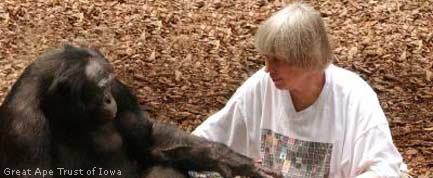Where Words Come From

I want to tell you something. Wait, wait, I'm searching for the right word to begin. I just can't remember it. Oh, there it is ... We all fumble around for the right word, and once you get to a certain age, that fumbling often ends with, "Ah, another senior moment," and the secret worry that dementia is around the corner. Researchers at Rice University in Houston have just discovered that there is a particular part of the brain that guides us when choosing words. On an MRI brain scan, the left temporal cortex and the LIGF, an area that encompasses Broca's area, which is known for speech production, light up when people are trying to choose between two words. The researchers were also able to pinpoint those two areas as the spots for word choice when testing subjects with brain damage. Any research that informs us about language production is important because words are what make humans special.
No one knows when people began to speak, but anthropologists assume that talking came when we emerged as fully human, about 200,000 years ago. Of course, there was communication before that. All animals have ways to convey their feelings to others — dogs bark, birds sing, monkeys screech — but in most cases individuals are calling out their immediate situation. That communication is important because those calls can mean the difference between life and death. But it gets interesting when animals have something else to say besides, "Help! That eagle is going to eat me." And it's not just humans who choose the right words. Anthropologists have dragged recorded equipment into the field to figure out exactly what nonhuman primates say to each other. They recorded the animals in various social situations and then replayed the recordings to see the animals' reactions. It turns out that monkeys can identify calls from individual troop mates, that is, they "know" each others' voices, and they use this information selectively. And the grunts, calls, and screams of primates carry more information than the emotional reaction of fear or contentment. In other words, they have words, of a sort. For example, rhesus monkey mothers can tell if their kids are really in trouble. When a juvenile is being attacked by a relative, it seems, they call out in a fake-y way and mothers ignore them. But if the kid is being attacked by a non-relative, someone who really might hurt them, the mother goes running. And the kid does this using "words" alone. The words we primates choose are especially important in social interactions. Anthropologist John Mitani of the University of Michigan analyzed the shape of the male chimpanzee's classic "pant-hoot," a call that starts out with a low "huh, huh, huh" and then builds to a scream. He compared this call from two sites in Tanzania and found that males modulate their voices to sound like each other, much as we take account of the accent of another country or culture when we move around. Sounding like each other, Mitani thinks, is important to male chimps because they are tightly bonded. Males hang out together, patrol the borders of a territory together and hunt together. We don't know why exactly humans developed their word play beyond grunts and screams. But in doing so, we gained the ability to talk about more than predators and more than each other. Unlike other primates, we can choose the right words to describe a dream, or talk about our goals. We can tell a story, or write a column, if only we can find the right words.
- Video – Jane Goodall's Wild Chimpanzees
- Top 10 Mysteries of the Mind
- Amazing Animal Abilities
Meredith F. Small is an anthropologist at Cornell University. She is also the author of "Our Babies, Ourselves; How Biology and Culture Shape the Way We Parent" (link) and "The Culture of Our Discontent; Beyond the Medical Model of Mental Illness" (link).
Get the world’s most fascinating discoveries delivered straight to your inbox.
